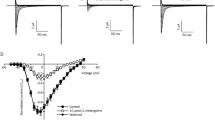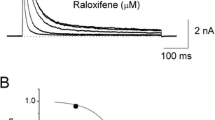Abstract
Pergolide mesylate, an ergot-derivative dopamine receptor agonist, is prescribed for the management of patients with Parkinson’s disease. Pergolide caused vasoconstriction in a pulmonary artery. Kv1.5 channel is highly expressed in pulmonary arterial smooth muscle cells, where it plays an important role as a determinant of vascular tone. In the present study, we investigated the effects of pergolide on Kv1.5 stably expressed in Chinese hamster ovary cells using the whole-cell patch-clamp technique. The Kv1.5 block by pergolide was concentration-, time-, voltage-, and use-dependent. Pergolide blocked Kv1.5 currents in a concentration-dependent manner, with an IC50 value of 15.4 μM and a Hill coefficient of 1.7. The activation and inactivation of Kv1.5 were significantly accelerated by pergolide in a concentration-dependent manner. The apparent association and dissociation rate constants were 0.43 μM−1 s−1 and 8.34 s−1, respectively, with a K D value of 19.1 μM. Pergolide slowed deactivation kinetics of Kv1.5, resulting in a tail crossover phenomenon. The block of Kv1.5 by pergolide was voltage-dependent, increasing significantly at test potentials from −10 to +10 mV, whereas the current was reduced slightly with a shallower voltage dependence in the range between +20 and +50 mV (δ = 0.34). There was a significant hyperpolarizing shift in the voltage dependence of steady-state inactivation of Kv1.5. Pergolide produced a use-dependent Kv1.5 block at 1 and 2 Hz, and also slowed the time course for recovery from inactivation. These results suggest that pergolide has an affinity for the open and inactivated states of Kv1.5 channels.







Similar content being viewed by others

References
Archer SL, Wu XC, Thebaud B, Nsair A, Bonnet S, Tyrrell B, McMurtry MS, Hashimoto K, Harry G, Michelakis ED (2004) Preferential expression and function of voltage-gated, O2-sensitive K+ channels in resistance pulmonary arteries explains regional heterogeneity in hypoxic pulmonary vasoconstriction: ionic diversity in smooth muscle cells. Circ Res 95:308–318
Brendel J, Peukert S (2003) Blockers of the Kv1.5 channel for the treatment of atrial arrhythmias. Curr Med Chem Cardiovasc Hematol Agents 1:273–287
Butterworth JFt, Strichartz GR (1990) Molecular mechanisms of local anesthesia: a review. Anesthesiology 72:711–734
Choi BH, Choi JS, Jeong SW, Hahn SJ, Yoon SH, Jo YH, Kim MS (2000) Direct block by bisindolylmaleimide of rat Kv1.5 expressed in Chinese hamster ovary cells. J Pharmacol Exp Ther 293:634–640
Christ T, Wettwer E, Voigt N, Hala O, Radicke S, Matschke K, Varro A, Dobrev D, Ravens U (2008) Pathology-specific effects of the IKur/Ito/IK, ACh blocker AVE0118 on ion channels in human chronic atrial fibrillation. Br J Pharmacol 154:1619–1630
Delpon E, Caballero R, Valenzuela C, Longobardo M, Snyders D, Tamargo J (1999) Benzocaine enhances and inhibits the K+ current through a human cardiac cloned channel (Kv1.5). Cardiovasc Res 42:510–520
Evrard F, Dupuis M, Muller T, Jacquerye P (2008) Isolated pulmonary hypertension and pergolide. Rev Neurol (Paris) 164:278–279
Faggiano P, Antonini-Canterin F, Ribichini F, D’Aloia A, Ferrero V, Cervesato E, Pavan D, Burelli C, Nicolosi G (2000) Pulmonary artery hypertension in adult patients with symptomatic valvular aortic stenosis. Am J Cardiol 85:204–208
Fedida D, Wible B, Wang Z, Fermini B, Faust F, Nattel S, Brown AM (1993) Identity of a novel delayed rectifier current from human heart with a cloned K+ channel current. Circ Res 73:210–216
Franqueza L, Valenzuela C, Delpon E, Longobardo M, Caballero R, Tamargo J (1998) Effects of propafenone and 5-hydroxy-propafenone on hKv1.5 channels. Br J Pharmacol 125:969–978
Fuller RW, Clemens JA (1991) Pergolide: a dopamine agonist at both D1 and D2 receptors. Life Sci 49:925–930
Hong Z, Smith AJ, Archer SL, Wu XC, Nelson DP, Peterson D, Johnson G, Weir EK (2005) Pergolide is an inhibitor of voltage-gated potassium channels, including Kv1.5, and causes pulmonary vasoconstriction. Circulation 112:1494–1499
Horvath J, Fross RD, Kleiner-Fisman G, Lerch R, Stalder H, Liaudat S, Raskoff WJ, Flachsbart KD, Rakowski H, Pache JC, Burkhard PR, Lang AE (2004) Severe multivalvular heart disease: a new complication of the ergot derivative dopamine agonists. Mov Disord 19:656–662
Hurst RS, Higdon NR, Lawson JA, Clark MA, Rutherford-Root KL, McDonald WG, Haas JV, McGrath JP, Meglasson MD (2003) Dopamine receptor agonists differ in their actions on cardiac ion channels. Eur J Pharmacol 482:31–37
Jeong I, Choi BH, Hahn SJ (2010) Effects of lobeline, a nicotinic receptor ligand, on the cloned Kv1.5. Pflugers Arch 460:851–862
Jeong I, Choi BH, Yoon SH, Hahn SJ (2012) Carvedilol blocks the cloned cardiac Kv1.5 channels in a β-adrenergic receptor-independent manner. Biochem Pharmacol 83:497–505
Kass RS, Cabo C (2000) Channel structure and drug-induced cardiac arrhythmias. Proc Natl Acad Sci USA 97:11683–11684
Knobloch K, Brendel J, Peukert S, Rosenstein B, Busch AE, Wirth KJ (2002) Electrophysiological and antiarrhythmic effects of the novel IKur channel blockers, S9947 and S20951, on left vs. right pig atrium in vivo in comparison with the IKr blockers dofetilide, azimilide, d,l-sotalol and ibutilide. Naunyn Schmiedebergs Arch Pharmacol 366:482–487
Leibowitz M, Lieberman A, Goldstein M, Neophytides A, Kupersmith M, Gopinathan G, Mehl S (1981) Cardiac effects of pergolide. Clin Pharmacol Ther 30:718–723
Mondal BK, Suri S (2000) Pergolide-induced retroperitoneal fibrosis. Int J Clin Pract 54:403
Moudgil R, Michelakis ED, Archer SL (2006) The role of K+ channels in determining pulmonary vascular tone, oxygen sensing, cell proliferation, and apoptosis: implications in hypoxic pulmonary vasoconstriction and pulmonary arterial hypertension. Microcirculation 13:615–632
Oka H, Mochio S, Sato H, Katayama K (1997) Prolongation of QTc interval in patients with Parkinson’s disease. Eur Neurol 37:186–189
Perez-Lloret S, Rascol O (2010) Dopamine receptor agonists for the treatment of early or advanced Parkinson’s disease. CNS Drugs 24:941–968
Rasmussen VG, Ostergaard K, Dupont E, Poulsen SH (2011) The risk of valvular regurgitation in patients with Parkinson’s disease treated with dopamine receptor agonists. Mov Disord 26:801–806
Ravens U, Wettwer E (2011) Ultra-rapid delayed rectifier channels: molecular basis and therapeutic implications. Cardiovasc Res 89:776–785
Remillard CV, Tigno DD, Platoshyn O, Burg ED, Brevnova EE, Conger D, Nicholson A, Rana BK, Channick RN, Rubin LJ, O’Connor DT, Yuan JX (2007) Function of Kv1.5 channels and genetic variations of KCNA5 in patients with idiopathic pulmonary arterial hypertension. Am J Physiol Cell Physiol 292:C1837–C1853
Rubin A, Lemberger L, Dhahir P (1981) Physiologic disposition of pergolide. Clin Pharmacol Ther 30:258–265
Scholz H, Trenkwalder C, Kohnen R, Riemann D, Kriston L, Hornyak M (2011) Dopamine agonists for restless legs syndrome. Cochrane Database Syst Rev: CD006009
Slawsky MT, Castle NA (1994) K+ channel blocking actions of flecainide compared with those of propafenone and quinidine in adult rat ventricular myocytes. J Pharmacol Exp Ther 269:66–74
Snyders DJ, Yeola SW (1995) Determinants of antiarrhythmic drug action. Electrostatic and hydrophobic components of block of the human cardiac hKv1.5 channel. Circ Res 77:575–583
Snyders J, Knoth KM, Roberds SL, Tamkun MM (1992) Time-, voltage-, and state-dependent block by quinidine of a cloned human cardiac potassium channel. Mol Pharmacol 41:322–330
Snyders DJ, Tamkun MM, Bennett PB (1993) A rapidly activating and slowly inactivating potassium channel cloned from human heart. Functional analysis after stable mammalian cell culture expression. J Gen Physiol 101:513–543
Tamargo J, Caballero R, Gomez R, Valenzuela C, Delpon E (2004) Pharmacology of cardiac potassium channels. Cardiovasc Res 62:9–33
Tanner CM, Chhablani R, Goetz CG, Klawans HL (1985) Pergolide mesylate: lack of cardiac toxicity in patients with cardiac disease. Neurology 35:918–921
Wang Z, Fermini B, Nattel S (1993) Sustained depolarization-induced outward current in human atrial myocytes. Evidence for a novel delayed rectifier K+ current similar to Kv1.5 cloned channel currents. Circ Res 73:1061–1076
Wang Z, Fermini B, Nattel S (1995) Effects of flecainide, quinidine, and 4-aminopyridine on transient outward and ultrarapid delayed rectifier currents in human atrial myocytes. J Pharmacol Exp Ther 272:184–196
Weir EK, Olschewski A (2006) Role of ion channels in acute and chronic responses of the pulmonary vasculature to hypoxia. Cardiovasc Res 71:630–641
Weir EK, Lopez-Barneo J, Buckler KJ, Archer SL (2005) Acute oxygen-sensing mechanisms. N Engl J Med 353:2042–2055
Woodhull AM (1973) Ionic blockage of sodium channels in nerve. J Gen Physiol 61:687–708
Yuan XJ (1995) Voltage-gated K+ currents regulate resting membrane potential and [Ca2+]i in pulmonary arterial myocytes. Circ Res 77:370–378
Yuan XJ, Wang J, Juhaszova M, Golovina VA, Rubin LJ (1998) Molecular basis and function of voltage-gated K+ channels in pulmonary arterial smooth muscle cells. Am J Physiol 274:L621–L635
Ziemssen T, Reichmann H (2010) Cardiovascular autonomic dysfunction in Parkinson’s disease. J Neurol Sci 289:74–80
Acknowledgments
We thank Dr. Leonard K. Kaczmarek (Department of Pharmacology, Yale University School of Medicine, New Haven, CT, USA) for the Kv1.5 cDNA. This work was supported by a grant from the Medical Research Center, Korea Science and Engineering Foundation, Republic of Korea (R13-2002-005-01002-0).
Author information
Authors and Affiliations
Corresponding author
Rights and permissions
About this article
Cite this article
Jeong, I., Choi, B.H. & Hahn, S.J. Pergolide block of the cloned Kv1.5 potassium channels. Naunyn-Schmiedeberg's Arch Pharmacol 386, 125–133 (2013). https://doi.org/10.1007/s00210-012-0776-5
Received:
Accepted:
Published:
Issue Date:
DOI: https://doi.org/10.1007/s00210-012-0776-5



